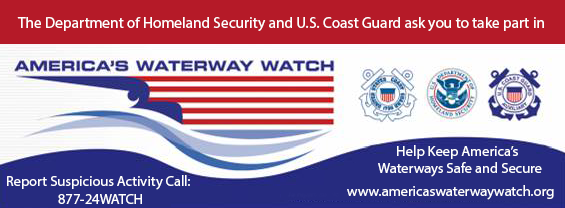7th District
Division 8 Flotilla 8-7
Englewood, Florida
(Lemon Bay -- Placida Harbor on Florida's Gulf Coast)

Safe Boating Tips
Boaters are reminded not to anchor under bridges or in channels and not to violate security zones or restricted areas. Boaters should not approach military, cruise line, or escorted commercial shipping vessels. There is a 100-yard security zone around all these vessels. Boaters are prohibited from areas near commercial port operation areas and petroleum facilities. America's Waterway Watch Program
America's Waterway Watch (AWW), a combined effort of the Coast Guard and its Reserve and Auxiliary components enlisting the participation of those who live, work or play around America's waterfront areas. Coast Guard Reserve personnel concentrate on connecting with businesses and government agencies, while Auxiliarists focus on building AWW awareness among the recreational boating public.
If you are a tow boat operator, a recreational boater, a fisherman, a marina operator, or otherwise live, work or engage in recreational activities around America's waterways, the United States Coast Guard wants your help in keeping these areas safe and secure. You can do this by participating in its America's Waterway Watch program, a nationwide initiative similar to the well known and successful Neighborhood Watch program that asks community members to report suspicious activities to local law enforcement agencies. Click here for the Waterway Watch Facebook site.
You should always remember that people are not suspicious, behavior is. And if you observe suspicious behavior or activity, you should simply note the details and contact local law enforcement. You are not expected to approach or challenge anyone acting in a suspicious manner.
To report suspicious activity call the National Response Center at 877-249-2824. If there is an immediate danger to life or property call 911 or call the U.S.C.G. on Marine Channel 16.
Maritime Security
The Coast Guard employs a three-tiered system of Maritime Security (MARSEC) Levels designed to easily communicate to the Coast Guard and our maritime industry partners pre-planned scalable responses for credible threats. If the Secretary of Homeland Security issues an NTAS Alert, the Commandant of the U.S. Coast Guard will adjust MARSEC Level, if appropriate, based on the commensurate risk, any maritime nexus, and/or Commandant consultation with the Secretary of Homeland Security.
MARSEC Levels are set to reflect the prevailing threat environment to the marine elements of the national transportation system, including ports, vessels, facilities, and critical assets and infrastructure located on or adjacent to waters subject to the jurisdiction of the U.S. MARSEC Levels apply to vessels, Coast Guard-regulated facilities inside the U.S., and to the Coast Guard.
- MARSEC Level 1
- Means the level for which minimum appropriate security measures shall be maintained at all times.
- MARSEC Level 2
- Means the level for which appropriate additional protective security measures shall be maintained for a period of time as a result of heightened risk of a transportation security incident.
- MARSEC Level 3
- Means the level for which further specific protective security measures shall be maintained for a limited period of time when a transportation security incident is probable, imminent, or has occurred, although it may not be possible to identify the specific target.
MARSEC Level 1 generally applies in the absence of an NTAS Alert or when the Commandant determines that the Alert is not applicable to the Marine Transportation System. If an NTAS Alert is applicable, the Commandant will consider a MARSEC Level change for the maritime industry, Coast Guard, or both.



